Learn more about Urbanism Next:
[embeddoc url=”https://urbanismnext.uoregon.edu/files/2017/06/Urbanism-Next-Framework_080618-t65jcs.pdf” download=”all” viewer=”google” ]
While the Urbanism Next blog presents a compilation of research and articles from a variety of sources, we are also conducting our own research. This page includes a series of papers on issues related to Urbanism Next. The intention is to introduce you to some key topics that will be affecting how cities develop as they face ongoing and transformative changes in technology.
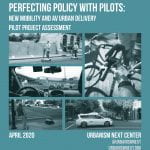 Perfecting Policy with Pilots: New Mobility and AV Delivery Pilot Project Assessment is an assessment of 220 pilot projects from around the country.
Perfecting Policy with Pilots: New Mobility and AV Delivery Pilot Project Assessment is an assessment of 220 pilot projects from around the country.
Urbanism Next Framework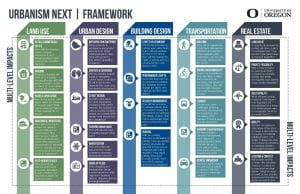 (Urbanism Next) One of the key challenges cities face is understanding the range of areas that are being affected or will be affected by emerging technologies, and how these areas are related. The Urbanism Next Framework organizes impacts based on five key areas— land use, urban design, building design, transportation, and real estate—and relates those to the implications they have on equity, health and safety, the environment, and the economy. It then considers what we should do to ensure that emerging technologies help communities achieve their goals.
(Urbanism Next) One of the key challenges cities face is understanding the range of areas that are being affected or will be affected by emerging technologies, and how these areas are related. The Urbanism Next Framework organizes impacts based on five key areas— land use, urban design, building design, transportation, and real estate—and relates those to the implications they have on equity, health and safety, the environment, and the economy. It then considers what we should do to ensure that emerging technologies help communities achieve their goals.
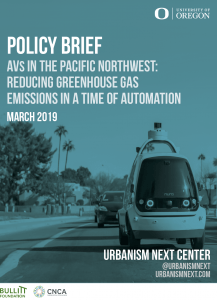 Policy Brief: AVs in the Pacific Northwest: Reducing Greenhouse Gas Emissions in a Time of Automation (Howell, Larco, Lewis, and Steckler) summarizes the key takeaways from New Mobility in the Right-of-Way and AVs in the Pacific Northwest. (Both reports are included below.) This policy brief outlines our main findings and includes a series of process/procedural and policy recommendations for cities to consider as they adopt new mobility plans and enable automated vehicles.
Policy Brief: AVs in the Pacific Northwest: Reducing Greenhouse Gas Emissions in a Time of Automation (Howell, Larco, Lewis, and Steckler) summarizes the key takeaways from New Mobility in the Right-of-Way and AVs in the Pacific Northwest. (Both reports are included below.) This policy brief outlines our main findings and includes a series of process/procedural and policy recommendations for cities to consider as they adopt new mobility plans and enable automated vehicles.
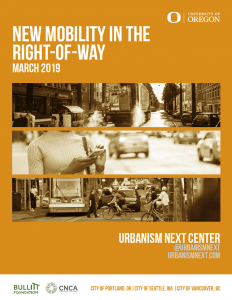 New Mobility in the Right-of-Way (Howell, Larco, Lewis, and Steckler) explores the ways in which demand for the right-of-way, broadly, but the curb, more specifically, is changing. The curb has long been in high demand with multiple users vying for limited space, especially for the purposes of parking personal vehicles. However, TNCs and other services have helped to usher in a new age that involves an increased demand for short-term loading and micromobility device parking. AVs will likely exacerbate existing issues with the right-of-way and the curb, which is why it is important that cities tackle curb management in new ways. This report categorizes and summarizes efforts that are already underway in cities across the world to rethink curb management and identifies major research gaps. New Mobility in the Right-of-Way summarizes the second phase of research from a project involving the Carbon Neutral Cities Alliance at the Urban Sustainability Directors Network (CNCA/USDN) and the cities of Portland, OR; Seattle, WA; and Vancouver, BC, and was generously supported by the Bullitt Foundation.
New Mobility in the Right-of-Way (Howell, Larco, Lewis, and Steckler) explores the ways in which demand for the right-of-way, broadly, but the curb, more specifically, is changing. The curb has long been in high demand with multiple users vying for limited space, especially for the purposes of parking personal vehicles. However, TNCs and other services have helped to usher in a new age that involves an increased demand for short-term loading and micromobility device parking. AVs will likely exacerbate existing issues with the right-of-way and the curb, which is why it is important that cities tackle curb management in new ways. This report categorizes and summarizes efforts that are already underway in cities across the world to rethink curb management and identifies major research gaps. New Mobility in the Right-of-Way summarizes the second phase of research from a project involving the Carbon Neutral Cities Alliance at the Urban Sustainability Directors Network (CNCA/USDN) and the cities of Portland, OR; Seattle, WA; and Vancouver, BC, and was generously supported by the Bullitt Foundation.
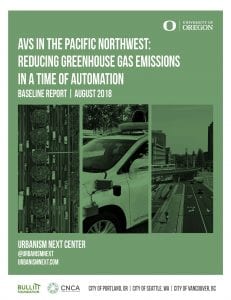 AVs in the Pacific Northwest: Reducing Greenhouse Gas Emissions in a Time of Automation (Larco, Howell, Lewis, and Steckler). The policy decisions made over the next 10 years that shape the deployment of autonomous vehicles (AVs) will have significant repercussions for our communities as well as environmental repercussions related to greenhouse gas emissions and adaptation to climate change. In recognition of that, Urbanism Next worked with the cities of Portland, Seattle, and Vancouver, BC to better understand how new mobility technologies such as AVs could affect greenhouse gas emissions thereby impacting their ability to achieve the goals in their respective climate action plans. This project grew out of a partnership between the Carbon Neutral Cities Alliance at the Urban Sustainability Directors Network (CNCA/USDN) and the Cities of Portland, Seattle, and Vancouver and was generously supported by the Bullitt Foundation.
AVs in the Pacific Northwest: Reducing Greenhouse Gas Emissions in a Time of Automation (Larco, Howell, Lewis, and Steckler). The policy decisions made over the next 10 years that shape the deployment of autonomous vehicles (AVs) will have significant repercussions for our communities as well as environmental repercussions related to greenhouse gas emissions and adaptation to climate change. In recognition of that, Urbanism Next worked with the cities of Portland, Seattle, and Vancouver, BC to better understand how new mobility technologies such as AVs could affect greenhouse gas emissions thereby impacting their ability to achieve the goals in their respective climate action plans. This project grew out of a partnership between the Carbon Neutral Cities Alliance at the Urban Sustainability Directors Network (CNCA/USDN) and the Cities of Portland, Seattle, and Vancouver and was generously supported by the Bullitt Foundation.
Rethinking Streets in an Era of Driverless Cars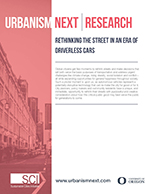 (Schlossberg, Riggs, Millard-Ball and Shay) presents ideas about how city planners, policy makers and community residents can address the introduction of autonomous vehicles. This white paper frames the introduction of AVs as an opportunity to rethink streets with purposeful and creative consideration about how this critical public good may best serve the public for generations to come.
(Schlossberg, Riggs, Millard-Ball and Shay) presents ideas about how city planners, policy makers and community residents can address the introduction of autonomous vehicles. This white paper frames the introduction of AVs as an opportunity to rethink streets with purposeful and creative consideration about how this critical public good may best serve the public for generations to come.
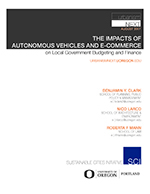 The Impact of AVs and E-Commerce on Local Government Budgeting and Finance (Clark, Larco and Mann) is a new report from us here at Urbanism Next/SCI that takes you through a city’s budget —both revenues and expenditures — and describes the areas that will be affected as AVs become commonplace and e-commerce takes on an even larger role in retail. City leaders have to start planning for this future now if they want to have a voice in what AVs/e-commerce will do to their cities.
The Impact of AVs and E-Commerce on Local Government Budgeting and Finance (Clark, Larco and Mann) is a new report from us here at Urbanism Next/SCI that takes you through a city’s budget —both revenues and expenditures — and describes the areas that will be affected as AVs become commonplace and e-commerce takes on an even larger role in retail. City leaders have to start planning for this future now if they want to have a voice in what AVs/e-commerce will do to their cities.
 Re-Imagining Retail (Carlson and Larco) builds on earlier posts about the challenges retail is currently facing, we look at the transformation retail is currently going through and the shift from brick-and-mortar, to e-commerce, to omnichannel approaches. The paper describes trends and includes data and resources that can help you understand where we are at, where we are heading, and where you can learn more.
Re-Imagining Retail (Carlson and Larco) builds on earlier posts about the challenges retail is currently facing, we look at the transformation retail is currently going through and the shift from brick-and-mortar, to e-commerce, to omnichannel approaches. The paper describes trends and includes data and resources that can help you understand where we are at, where we are heading, and where you can learn more.
 Warehousing (Carlson and Larco) looks at the changing nature of distribution networks with the rise of E-Commerce and the effects this will have on the size, number and distribution of Warehouses in cities.
Warehousing (Carlson and Larco) looks at the changing nature of distribution networks with the rise of E-Commerce and the effects this will have on the size, number and distribution of Warehouses in cities.
And the milestones keep coming. Las Vegas just made active the country’s first AV public transit shuttle. These type of fixed lines routes (transit lines) are obvious choices as early adopters as the environmental variables are limited. The bus is small – 12 passenger – and the route is short but it is yet another step towards full automation of the transit system.
This type of vehicle is potentially going to be doing the heavy lifting for paratransit and shared trips in the near future. Picture something like this coming to pick you up next time you use uberPOOL or Lyft Line.
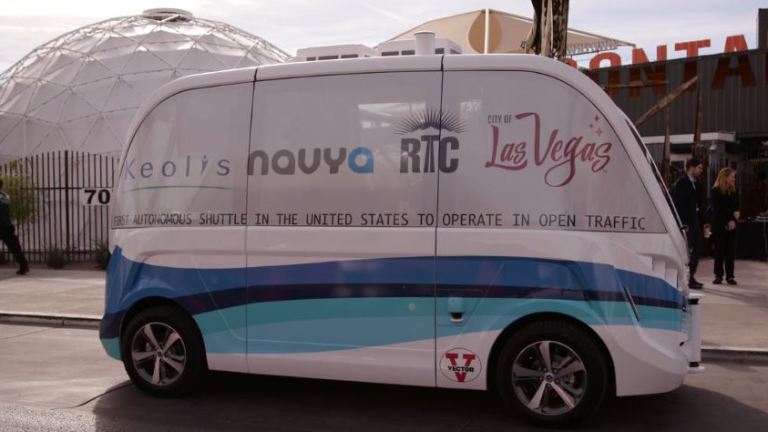
A recent article in the Wall Street Journal documents the continued rise of e-commerce coupled with the inevitable slide of brick-and-mortar stores. A few key numbers:
Probably the most striking number for the subject of this blog, brick-and-mortar shopping traffic (as in the number of times people went into stores) declined by 12%. That number – if it continues – will inevitably lead to a drop in the amount of brick-and-mortar stores and major shifts in land use and transportation demand. This will potentially also decrease the vitality and activity around commercial areas.
CityLab has posted a report from this years Consumer Electronics Show and – unsurprisingly – the roll-out of AV’s seems to be focused on shared fleets and they will focus on freight and high occupancy transport. Cost seems to be the largest factor early on with AV technology being cost-prohibitive for individual ownership (although Tesla might have something to say about that). Another reason is simply the ability to monitor and modify cars and algorithms – much easier to do roll-out and testing in limited contact points via larger shared fleets.
This is not to say that shared vehicles are the only future for AV’s – but thier initiation happening as shared vehicles is promising and gives a bit of time to figure out how best to promote and cement that future over individual ownership – probably the most critical issue in avoiding a dystopian future.

Another article here on Amtrak and local transit in North Carolina coordinating with Uber to help riders overcome first/last mile issues. An app will show how combinations of rail, bus, and ridesourceing can get people where they need to go. There has been a trend nationally for this kind of collaboration.
Of interest will be transit organizations’ ability to gather data on these trips to see if Uber trips end up replacing transit or if they are really extending the accessibility of transit itself
A few positive developments for the future of transit today! As we have discussed before – the question of transit + ridesourcing (Uber/Lyft) as opposed to transit vs. ridesourcing will be one of the most fundamental questions to how cities develop in an AV future. If there is collaboration, accessibility can increase tremendously without (as much) increase in congestion or a push towards sprawl. If they are in competition – and ridesourcing triumphs in a way that makes transit unfeasible – we are in for the darkest of futures (see previous posts for more on this). So now – onto the news:
In Seattle, Uber is endorsing the cities $54 Billion (with a ‘B’) transit ballot initiative. Uber has not traditionally endorse ballot initiatives one way or another, but the fact they are supporting transit, coupled with the partnerships they are developing with cities to work cooperatively in the mobility world points to a promising future. Of interest in the article is also Uber’s Seattle General Manager’s quote that Uber’s mission is to “reduce congestion and pollution by moving more people with fewer cars, and provide better mobility options for all people living in the region.” Uber and transit combining to be mobility/accessibility companies, and not ridesource and transit individually, is a large step in the right direction.
In that same vein, this article talks about AV paratransit being developed in Hillsborough, Florida – launch expected in 2017. Could be a great option for hardest to serve and for first/last mile access to transit.
This article looks at what cars mean to us culturally and how that would change with AV’s. It reads as a bit of a swansong – a distant echo of people lamenting their relationship to their horses was about to change as cars first took over cities.
As strange as it may seem to those of us who came of age pre-2010 – and it remains to be seen – but it is hard to imagine the eight year old of today growing up to a moment in their early twenties when dumping thousands of dollars into a car seems like a good idea – not with uber, lyft, car2go, car share, bike share, etc etc out there.
Wired just published this article which gathers views of thinkers from around the country. A quick, light read that gives some broad strokes of what we might expect.
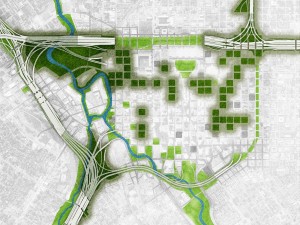 Source: SWA/Kinder Baumgardner
Source: SWA/Kinder Baumgardner
Related to the previous post, here is another positive push for transit and shared mobility working together and not in competition. This report put out by TCRP talks about how transit agencies can re-imagine themselves as mobility agencies that use a wide range of mobility options (typical transit, paratransit, rideshare, ridesourcing, carshare, bikeshare, etc). Excellent thinking and research in there.
There is also an accompanying webinar recording here that summarizes the report. This webinar talks about all of the possible, progressive futures, but also warns how detrimental a future with only AV cars (and no transit/paratransit) would be.
In another hopeful move that transit and ridesourcing services like Uber and Lyft will be combining efforts to better provide accessibility and mobility for all, FTA this week announced nearly $8 million in grants – mostly to transit agencies – to incorporate mobility-on-demand into their agencies. Take a look at the funded projects here.
Zack Kanter’s post on AV’s is a well researched take on what the rollout of AV’s will look like. He describes the steps we will move through and some of the immediate fallout of these steps. Good series of citations (for those looking for more than opinions about these things).
This is a two part series from City Observatory that talks about the projected cost of autonomous vehicles and the effects this will have on their adoption (and their marketshare). The first article cityobservatory.org/how-much-will-autonomous-vehicles-cost/ has a collection of cost estimates from various sources. The second article http://cityobservatory.org/price-of-autonomous-cars/ looks at the effects of pricing on everything from AV’s effect on transit to the behavioral effects of our being more aware of the cost of trips (as we may no longer have that sunk cost of the automobile).
The Urbanism Next Blog is focused on how changes in technology are reshaping the ways we live, move, and spend our time in cities. We are interested in emerging technologies such as autonomous vehicles (AV’s), the rise of E-Commerce, and the proliferation of the sharing economy. While other parts of the blogosphere are looking at the technological aspects of these advances, we are interested in the effects the they will have on cities and city design.
Urbanism Next is meant to be a source for those interested in technology and the built environment and is particularly targeted towards urban designers, architects, planners, landscape architects, and developers. Visit the blog for links to relevant articles, commentaries on emerging trends, and critical thinking around the future of our cities.
The Urbanism Next Blog is part of the Sustainable Cities Initiative’s (SCI) Urbanism Next Research Initiative at the University of Oregon.
Advances in technology such as the advent of autonomous vehicles (AVs), the rise of E-commerce, and the proliferation of the sharing economy are having profound effects not only on how we live, move, and spend our time in cities, but also increasingly on urban form and development itself. The University of Oregon’s Urbanism Next Center focuses on the ramifications of these changes. Researchers are working with leaders from the public, private, and academic sectors across North America and Europe to better understand the secondary impacts of emerging technologies on cities and ensure that governments from the local to federal level have the information they need to make informed decisions that improve equity and health outcomes, as well as help achieve community goals related to the economy and the environment.
Urbanism Next is meant to be a source for those interested in technology and the built environment and is particularly targeted towards urban designers, architects, planners, landscape architects, and developers. The Urbanism Next Blog is part of the Sustainable Cities Initiative’s (SCI) Urbanism Next Research Center at the University of Oregon. Visit the blog for links to relevant articles, commentaries on emerging trends, and critical thinking around the future of our cities.
Learn more about Urbanism Next:
[embeddoc url=”https://urbanismnext.uoregon.edu/files/2017/06/Urbanism-Next-Framework_080618-t65jcs.pdf” download=”all” viewer=”google” ]